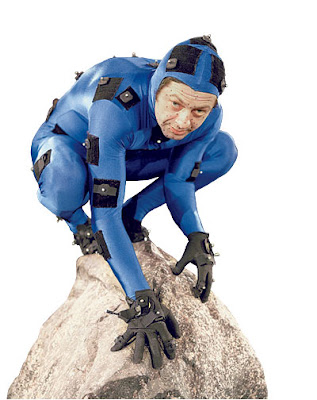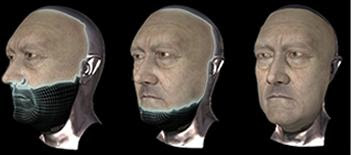Avatar: behind the computer generated skin there are real people bringing the characters to life
We have grown accustomed to the new alliance between animation and acting. It started with Hollywood stars lending their voice to animated characters (e.g. Tom Hanks in “The Polar Express”, Jim Carrey in “Horton hears a Who”, Johnny Depp in “Corpse Bride” and many more). But is has gone a few steps further, most of all by virtue of new advanced computer technology, to a point where both acting and animation need to be redefined. The first character on the movie-screen who became famous as a result is the fictional Gollum of “The Lord of the Rings”. The character indeed is fictional and the product of computer design (called CG: computer generated), yet his performance is acted by a real person, someone who has largely remained unknown. The same principle has been applied to manifold CG characters in ‘Avatar’, James Cameron’s most recent masterpiece (*) of imagineering including its delivery in 3D.

Actor Andy Serkis, who played Gollum in Lord of the Rings
Instead of making actors invisible the way it happens in traditional animation the new technology opens an array of opportunities for actors to exploit the best of their acting talents without being limited by their own skins, bones, body shape – and looks. In fact it can make the art of acting more pure and profound – more credible in the eyes of the public, if the entire appearance of the character is credible.
The idea of allowing people to step into the skin and bones of a (computer generated) fictional character is one that can trigger many new applications or developments beyond the fantasy world of Hollywood – and beyond moviemaking.
One such application already surfaced a few years ago when Discovery Channel used it not to bring fictional characters to life but – cg models of – historic figures in its “Virtual History” documentary “The secret plot to kill Hitler” (2004).

Hitler’s CG model in Discovery’s “Virtual History” documentary
By all accounts we have come to a stage where our own senses can not any longer – readily - distinguish real from unreal. Whatever or whoever moves on the screen by virtue of computer image regeneration technology – indeed, this is not just another ‘animation’ technology (**) - is as real to the public’s eye as any other character who is moving in his own skin.
The possibility of stepping into the skin and bones of a fictional – CG – character is a gadget that has found its way to some extent in the industry that largely moves parallel to moviemaking: the (computer) gaming industry. Character design, environment and game flexibility (the decisions a player can make in ‘acting’ the plot of the game) have become increasingly sophisticated and ‘real’. Especially with the advent of Wii games (by which the movements of the player’s hands, arms and body are transposed to the events on the screen) the dividing line between virtual and real has shifted by a further step.
I expect that the next generation of computer games will more fully embrace this incorporation of the individual player and the character(s) of the games and their environment. Wii technology and the experiences of Hollywood CG moviemaking will be combined in advanced homebound gadgets allowing our youth to (almost literally) step into another world and ‘be’ somebody else in whatever perilous journey or challenge they choose.
It doesn’t take much imagination to consider similar developments in other ‘virtual’ domains, especially the domain in which many millions of people across the world by now are spending much of their real-life time, the internet. We are still in the infancy of the internet as an increasingly ‘real’ meeting place – the fourth dimension in which people can move, play and ‘act’ through self-created images (profiles, nicknames etc.) and travel to places everywhere in the world without actually moving an inch from their seat.
We connect and talk in manifold “chat rooms”, we can already connect in self-created worlds through applications such as Second Life and SIMS 3, young people already play games with friends who – through the internet – appear in the disguise of a character on their own screen etcetera. The technology is there, the first applications are there. It only needs time to further develop into more realistic but also more adventurous online experiences.

People meeting in a multiplayer online game
There is a difference of course between joining an online gaming community and choose (or create) a fictional character who performs all kinds of fantastic feats in one-on-one fights or entire battles, and connecting with other people on the internet driven by one’s own identity and real-life objectives.
In both domains – online gaming and online communication – I foresee further shifts between the real and the virtual potentially moving to a point where the distinction no longer makes any sense. In fact I believe it would be realistic even today to embrace the virtual world as a ‘real dimension’ and to take ourselves seriously when we move into it, whether our objective is to communicate or to play. In a sense, what may hold us back from fully enjoying the fruits of our present day technologies is not the advancement (or limitations) of the technology itself but the adjustment of our own habits and (social) standards in this fourth dimension of our lives.
To underscore this point I need to go back to Avatar (and similar movies). Although many characters of the movie are computer generated, all characters require the same serious actor’s performance. The experience of the main character in the movie, whose mind and ‘body control senses’ are transported to an alien body and brains (created in a laboratory), is the actual personal experience of the actor as well: it has been just as real (or ‘unreal’) for the actor to imagine himself as for his character to fly giant reptiles, to move through a strange jungle of exotic plants and trees with other aliens, and to kill ferocious beasts. It takes a good actor to make this a fully credible experience.
Similarly, I believe, it takes a serious and skilled communicator to make the internet a credible medium for communication. In contrast, many people prefer to use the internet as a hideout, disguising themselves under a veil of anonymity and using the various platforms for communication to unload their discontent or to express themselves in (often vicious) terms which they wouldn’t dare to use in ‘real life’. Indeed, the key for the internet to fully become a serious medium is the maturity of our own behavior.
But having said this, I could foresee a development in which internet users create their own ‘avatar’ – a figure, a character but not necessarily fictional - by which they move, play and communicate on the internet in such realistic terms, perhaps even in 3D, that we have can serious meetings with people across the world almost as if we are sitting around the same table. And it wouldn’t surprise me if ultimately our mobility and physical congestion issues on the road will largely be solved by new and credible ways to move – and act – on the avenues of the world wide web. In this perspective “working out of home” will – or at least: can – become a way of moving from one place to the other in a much more extensive way than by merely sending and receiving e-mails or by talking via msn and similar media.
Hence, if we take the internet serious and act-for-real our present day technologies bear the promise of a wonderful future in which our human imagination and creativity have boundless opportunities to become productive in almost all dimensions of our lives.
-----
(*) It is a masterpiece most of all for its technical superiority and for the wonderful scenes it depicts. The story of Avatar is rather cliché. Many movies have used the same theme: a foreign power wishes to exploit new lands and threatens to destroy the indigenous population. Some individuals of the foreign power befriend the local people and decide to help them. Pfff... what's new. In fact the story is very similar to one of the first movies ever made, about man's journey to the moon (approx. 1902), and it almost literally follows the script of Disney's Atlantis, to mention another one.
(**) In an interview producer/director James Cameron calls it "captured performance".

